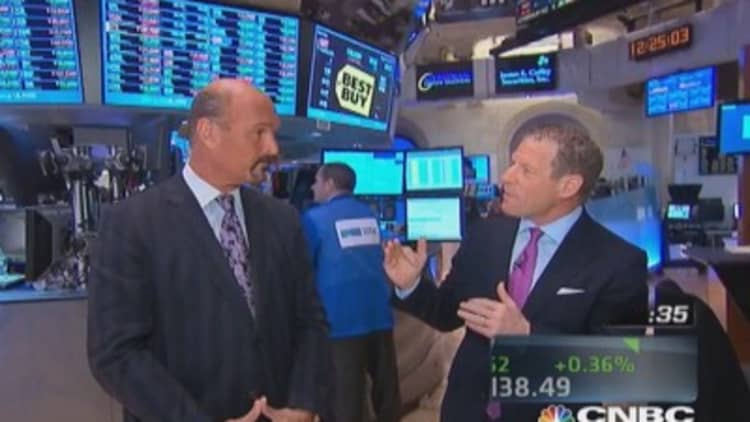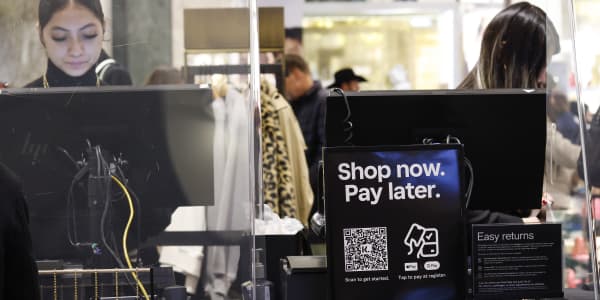Here we go. Thanksgiving is 10 days away. Then we wake up to a turkey and stuffing-induced hangover as millions of Americans rush to their nearest strip malls, sacrificing sleep for the crazy once-a-year discounts of Black Friday.
And 72 hours later is the main event: Cyber Monday. We fire up our laptops, switch on our iPads, and when we must walk, we do so while glued to our smartphones, searching for an even more unbelievably awesome deal than the one staring us in the face.
The story is the same every year, just more of it. Amazon.com keeps taking wallet share from the old big-box stores, and the old big-box stores do everything in their power to stay relevant. EMarketer predicts that holiday retail e-commerce sales in the U.S. will jump 17 percent to $72.4 billion, accounting for 24 percent of online sales for the full year. That's still only a sliver of the total holiday retail market (offline plus online), which eMarketer predicts will grow at the much slower 5 percent rate to $862.5 billion during the celebratory season.
Smartphone shopping is just gaining steam, thanks to better interfaces, faster connections and a ton of investment in mobile payments. According to a survey by Accenture, almost one-quarter of Americans plan to make a purchase from a smartphone this holiday season, up from 18 percent in 2013.
Read MoreBlack Friday deals debunked
But how does all this stuff happen, and with such speed? Who keeps it from breaking? Who makes sure my stuff arrives on time? If my packages are a day late—the horror!—who do I call? In short, who are the magicians behind e-commerce?
All this week, CNBC.com will be exploring these questions and more in a series called "Powering the holidays." We'll look into what's happening behind the scenes at some of your favorite e-retailers and tell you about some of the hidden winners in the ever-increasing rush to the Web. It's not a comprehensive series—nobody has THAT much time—but hopefully we can shed some light on the little-known technologies that make consumers happy and allow cyber merchants to thrive.
The name Amazon will come up with frequency, but not because we have any inside knowledge on the industry giant. Amazon builds its own infrastructure, has its own warehouses and employs scores of data scientists to predict what you want, when and how (drones aren't delivering just yet).

Nobody else can do it. Competitors have to buy the types of technologies that Amazon owns. In an always-on, multi-device, data-driven world, the old stuff doesn't work, so there's a whole new toolkit that merchants have to employ.
Nordstrom, the 113-year-old retailer headquartered just a few blocks away from Amazon in Seattle, has announced plans to spend $1.2 billion on technology through 2018, about 30 percent of its total capital expenditure costs over that stretch.
"We're constantly evolving and improving, whether it's the online or in-store experience, and using technology to make that experience as easy as possible," said Dan Evans, a spokesman for Nordstrom. He added that Amazon isa "great competitor that's changed what a customer thinks about a great experience."
Read MoreNordstrom: Strategy grounded in consumer
Wonder why so many emerging business technology companies that you've never heard of are valued in the billions of dollars? They're the ones selling the new infrastructure, applications and services, and they're displacing the old guard of standbys that were founded in the pre-smartphone and in many cases the pre-Internet days. Just last week, enterprise software developers New Relic and Hortonworks filed to sell shares to the public, joining the IPO parade.
"For any new workloads, the incumbents aren't relevant," said Matt Murphy, a partner at venture firm Kleiner Perkins Caufield & Byers in Menlo Park, California, and an investor in some of the start-ups we'll be highlighting this week. "The way enterprises are making technology decisions today has totally changed."
Read MoreIPOs: The next frontier
In other words, it's not just emerging companies that are deploying the latest and greatest and fastest solutions. Big companies are doing it too, painful as it may be to bid adieu to their old data center friends.
Traditional retailers also have to find ways to surface deals so they can remind shoppers that Amazon isn't the only game in town. Showrooming, where consumers walk through a store, find items they like, and then go buy them online (often at Amazon), is an accepted practice at this point. To fight it, one option retailers have is to match the lowest price available, even if it means losing money on a sale.
Perhaps the better approach is to make sure that their already discounted items actually get discovered.

BuyVia, a small start-up in San Mateo, California, provides an app that scours the Web for deals at the most popular retailers, and shows them to relevant users based on location and preference. It also shows Amazon's prices for the same product to keep shoppers from clicking over to go check—because they will.
Norman Fong, BuyVia's founder, knows that people across America want to shop at Best Buy, the Sports Authority and Nordstrom, and he's providing one piece of technology to help those stores compete in a smartphone-powered world.
"Amazon is the 10,000-pound gorilla out there," Fong said, in a recent interview. "But you can save money buying elsewhere."





